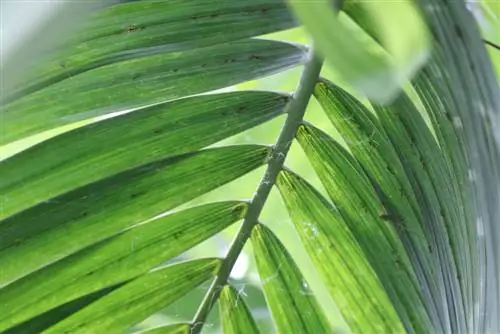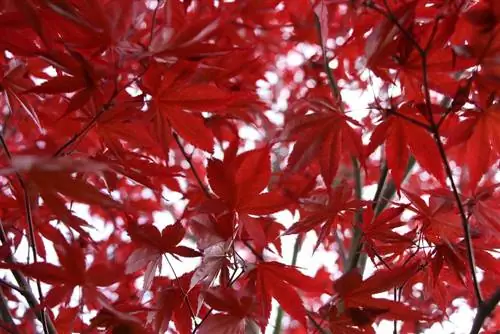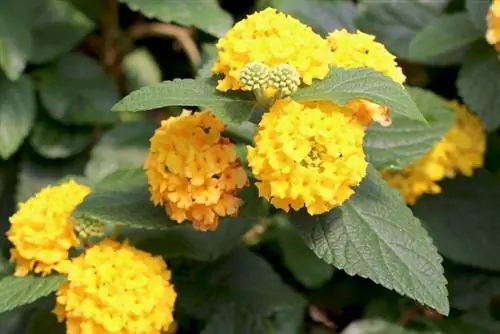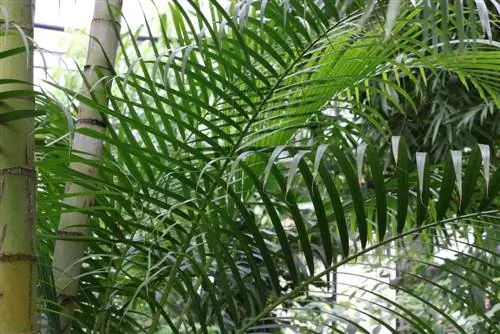- Author admin [email protected].
- Public 2023-12-17 03:39.
- Last modified 2025-01-24 12:45.
The Areca palm has the botanical name Dypsis lutescens and is also colloquially called the gold fruit palm or gold leaf palm. Due to its frost-sensitive properties, it can only thrive indoors or in a heated winter garden. The right lighting conditions are also important so that the plant can permanently maintain its green foliage. The plant has certain requirements when it comes to location and care criteria; no compromises are possible in this area.
Location & plant substrate
The Areca palm comes from the island of Madagascar and is therefore used to tropical weather conditions. However, the Dypsis lutescens grows there in light partial shade in the jungle and is protected from too much sun by larger trees. If the location in your home is extremely sunny, unsightly leaf discoloration occurs, which is irreversible. This discoloration of the leaves is golden yellow, which is where the name gold leaf palm comes from. However, the palm tree has no place in a very dark corner of the room, which is when what is known as yellowing occurs. During this process, the plant sprouts very thin and weak shoots because it is looking for sunlight. Ideal site conditions and the right planting substrate are very important for good growth, otherwise the Areca palm feels uncomfortable and grows poorly.
- A bright location without too much direct sunlight is ideal
- East windows or more in the middle of the room are ideal
- Be sure to avoid the blazing midday heat
- Think of shade for south and west-facing windows
- Curtains and roller shutters are well suited
- Needs warm room temperatures between 15-25° C
- Prefers well-drained soil with a slightly acidic pH value
- Pay attention to sandy to loamy soil qualities
- Enrich mixture of compost-based potting soil with perlite
- Alternatively, special palm soil can be used as a plant substrate
Tip:
If the incidence of light at the location of the Dypsis lutescens is very uneven, then the plant in its container should be rotated by a quarter every 2 weeks. In this way, the palm tree maintains a symmetrical growth habit and grows evenly in all directions.
Watering & Fertilizing
The gold leaf palm's need for water and nutrients depends on which phase it is currently in. In their tropical home there are two seasons, the extremely wet rainy season and the dry season with significantly less rainfall. Frequent rain affects the vegetation phase in the warm months, while Dypsis lutescens is in a growth pause in the cooler months. To protect the roots from too much standing water, a drainage layer over the drainage hole at the bottom of the pot is useful. In this way, the excess irrigation water can drain away easily and root rot can be sustainably prevented.
- High water requirements from April to October
- Keep the substrate moist at all times and never allow it to dry out completely
- Water often and a lot with low-lime water
- Surface should be slightly dry
- Only then administer the next pouring unit
- Limited water requirements from November to March
- Then only keep it moderately moist
- Always remove water from the coaster
- Avoid waterlogging at all costs
- Use liquid fertilizer every 2 weeks
- Special fertilizer for palm trees is ideal
- Do not fertilize during the rest period
Tip:
During the vegetation phase in the summer months, it is very helpful to place the root ball in a bucket of water every now and then. In this way, the roots can completely soak up moisture and the plant's high water requirements are largely covered.
Increase humidity
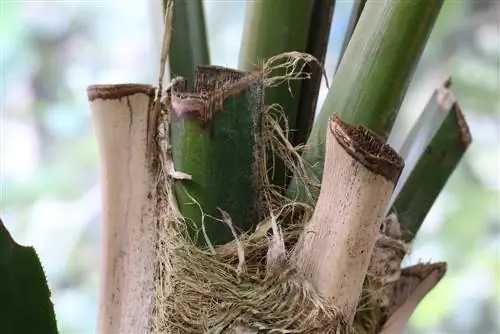
Due to its tropical origins, the Areca palm is used to high humidity in its location. Such high values do not normally occur in domestic living spaces. The average air humidity in living rooms here is very low and decreases significantly during the long heating period in winter. If this value is consistently too low, then the palm tree will thrive poorly and grow even more slowly. Therefore, the Dypsis lutescens must be helped in this area so that the plant can feel comfortable over the long term. A slightly raised coaster on which the palm tree is placed after it has been filled with pebbles and water offers first aid.
- Requires high humidity of 80-90% at the location
- Spray palm tree daily with lukewarm water
- Use a spray bottle with a very fine mist
- Rainwater, still mineral water or lime-free tap water is ideal
- Place containers filled with water on radiators in the winter months
- Indoor fountains are also well suited
- Alternatively, a nebulizer also helps
Tip:
The cultivation of the gold leaf palm in hydroculture is optimal, as this creates the required humidity over a long period of time. The corresponding air humidity can be easily measured in the respective room with a hygrometer.
Cutting
The Areca palm grows extremely slowly, so it only needs to be cut very rarely. In addition, no special pruning measures are necessary to maintain the distinctive growth of the gold leaf palm. However, it definitely makes sense to trim them from time to time, especially if a lot of withered leaves appear. In this case, however, the background to the wilting should also be researched.
- Growth per year is only about 15-20 cm
- Remove dead, yellow and dried leaves regularly
- Cut these close to the base
- Use only sharp and well-disinfected cutting tools
- Avoid harmful bruises and injuries at all costs
Repotting
Since the Areca palm grows very slowly, the plant does not need to be repotted too often. This process is necessary at the latest when individual roots grow out of the top of the planting substrate. In this case, it's time to move to a larger planter. This should provide the palm with sufficient downward space, as over time it will develop considerably long taproots. It is also important to have a sufficiently large drainage hole for excess irrigation water, which is located in the bottom of the pot. A lot of sensitivity is required when repotting, as the roots of the palm tree are very sensitive and react adversely to injuries. If the gold leaf palm has already developed a powerful growth habit, then another portion of solid garden soil should be added to the substrate. In this way, the stability in the plant pot can be significantly increased.
- The ideal time to move is spring or summer
- Repot young specimens annually
- On older and larger specimens only necessary about every 2-3 years
- First place the palm tree in a water bath to pot it better
- Then create drainage in the bucket
- Spread pebbles, perlite or pottery shards over the drain hole
- Fill in the first layer of plant substrate
- Place the palm tree in the middle of the new container, then add more soil
- Press the plant substrate lightly from time to time to avoid cavities
- Maintain the watering edge so that the water does not overflow
Propagate
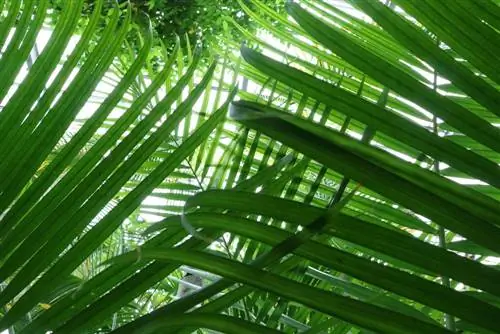
The Areca palm can be propagated from seeds and can be sown all year round. However, a sufficiently warm temperature is necessary for germination. In addition, with this method it takes a few years to grow a beautiful golden fruit palm. The plants can be propagated much more easily and quickly using their ground shoots. Older specimens only develop these ground shoots under ideal site conditions. To propagate, they are simply separated and placed in a smaller planter. In this way, the next generation of the gold leaf palm grows quickly. The following spring, the new Areca palm can then be moved to a larger pot with special palm soil.
- For sowing, temperatures of 18-25° C are required
- It takes a long time and depends on the right conditions
- Alternatively, ground shoots can be separated from the mother plant in spring
- Ground shoot should be at least 30 cm tall
- Pay attention to already developed roots
- Insert ground shoots individually into small pots
- The ideal substrate is compost soil mixed with a little sand
- Put the pots in a warm and bright place for a few weeks
- There must be no direct sunlight
- Water enough but not excessively
- Avoid fertilizing for the first few months
Tip:
If a transparent plastic film is placed over the planters, sowing and planting will go better and faster. With this method of cultivation, a few small holes must be made in the plastic film for ventilation.
Diseases & Pests
The Areca palm itself is quite robust and not easily susceptible to diseases and pests. These appear especially in winter when it is too cold and the air in the room is too dry. But it's not just incorrect location conditions that weaken the plant's immune system, errors in care also lead to this. The plant can react very sensitively to the pesticides from specialist retailers, so it is better to avoid using them.
- Check sheets regularly
- Spider mites, scale insects and mealybugs occasionally appear
- The red spider is also possible
- Fungal infection caused by sooty mold is less common
- If infested, carefully rinse the pests off the plant
- Wipe leaves carefully with cloths soaked in alcohol
- Spraying with a fine water mist helps preventatively

